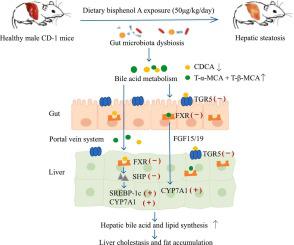当前位置:
X-MOL 学术
›
Sci. Total Environ.
›
论文详情
Our official English website, www.x-mol.net, welcomes your
feedback! (Note: you will need to create a separate account there.)
Bisphenol A induced hepatic steatosis by disturbing bile acid metabolism and FXR/TGR5 signaling pathways via remodeling the gut microbiota in CD-1 mice
Science of the Total Environment ( IF 8.2 ) Pub Date : 2023-05-20 , DOI: 10.1016/j.scitotenv.2023.164307 Ting Hong 1 , Jun Zou 2 , Youming He 3 , Hongmin Zhang 3 , Hao Liu 2 , Haiyan Mai 4 , Jie Yang 3 , Zhuo Cao 3 , Xiaobing Chen 3 , Jiale Yao 3 , Dan Feng 1
Science of the Total Environment ( IF 8.2 ) Pub Date : 2023-05-20 , DOI: 10.1016/j.scitotenv.2023.164307 Ting Hong 1 , Jun Zou 2 , Youming He 3 , Hongmin Zhang 3 , Hao Liu 2 , Haiyan Mai 4 , Jie Yang 3 , Zhuo Cao 3 , Xiaobing Chen 3 , Jiale Yao 3 , Dan Feng 1
Affiliation

|
Dysregulation of gut microbiota-mediated bile acid (BA) metabolism plays an important role in the pathogenesis of hepatic steatosis and nonalcoholic fatty liver disease (NAFLD). Our previous studies found that bisphenol A (BPA) exposure induced hepatic steatosis and gut microbiota dysbiosis. However, whether the gut microbiota-dependent BA metabolism alterations were involved in BPA-induced hepatic steatosis remains unclear. Therefore, we explored the gut microbiota-related metabolic mechanisms of hepatic steatosis induced by BPA. Male CD-1 mice were exposed to low-dose BPA (50 μg/kg/day) for 6 months. Fecal microbiota transplantation (FMT) and broad-spectrum antibiotic cocktail (ABX) treatment were further adopted to test the role of gut microbiota in the adverse effects of BPA. We found that BPA induced hepatic steatosis in mice. Additionally, 16S rRNA gene sequencing showed that BPA reduced the relative abundance of Bacteroides , Parabacteroides and Akkermansia , which are associated with BA metabolism. Metabolomic analyses demonstrated that BPA significantly altered the ratio of conjugated to unconjugated BAs and increased the total level of taurine-α/β-muricholic acid while decreasing the level of chenodeoxycholic acid, thus inhibiting the activation of special receptors, including farnesoid X receptor (FXR) and Takeda G protein-coupled receptor 5 (TGR5), in the ileum and liver. The inhibition of FXR reduced short heterodimer partner and subsequently induced cholesterol 7α-hydroxylase and sterol regulatory element-binding protein-1c expression, which is related to hepatic BA synthesis and lipogenesis, eventually leading to liver cholestasis and steatosis. Furthermore, we found that mice that received FMT from BPA-exposed mice developed hepatic steatosis, and the influences of BPA on hepatic steatosis and FXR/TGR5 signaling pathways could be eliminated by ABX treatment, confirming the role of gut microbiota in BPA effects. Collectively, our study illustrates that suppressed microbiota-BA-FXR/TGR signaling pathways may be a potential mechanism for hepatic steatosis induced by BPA, providing a new target for the prevention of BPA-induced NAFLD.
中文翻译:

双酚 A 通过重塑 CD-1 小鼠肠道菌群来干扰胆汁酸代谢和 FXR/TGR5 信号通路,从而诱导肝脂肪变性
肠道微生物群介导的胆汁酸 (BA) 代谢失调在肝脂肪变性和非酒精性脂肪性肝病 (NAFLD) 的发病机制中起重要作用。我们之前的研究发现,双酚 A (BPA) 暴露会诱导肝脏脂肪变性和肠道菌群失调。然而,肠道微生物群依赖性 BA 代谢改变是否与 BPA 诱导的肝脏脂肪变性有关仍不清楚。因此,我们探讨了 BPA 诱导的肝脂肪变性的肠道菌群相关代谢机制。雄性 CD-1 小鼠暴露于低剂量 BPA (50 μg/kg/天) 6 个月。进一步采用粪便微生物群移植 (FMT) 和广谱抗生素鸡尾酒 (ABX) 治疗来测试肠道菌群在 BPA 不良反应中的作用。我们发现 BPA 诱导小鼠肝脂肪变性。此外,16S rRNA 基因测序显示,BPA 降低了与 BA 代谢相关的拟杆菌门、副拟杆菌门和阿克曼氏菌的相对丰度。代谢组学分析表明,BPA 显着改变了结合与未结合 BA 的比例,增加了牛磺酸-α/β-穆里胆酸的总水平,同时降低了鹅去氧胆酸的水平,从而抑制了回肠和肝脏中特殊受体的激活,包括法尼醇 X 受体 (FXR) 和武田 G 蛋白偶联受体 5 (TGR5)。FXR 的抑制减少了短异二聚体伴侣,随后诱导胆固醇 7α-羟化酶和甾醇调节元件结合蛋白-1c 表达,这与肝脏 BA 合成和脂肪生成有关,最终导致肝胆汁淤积和脂肪变性。 此外,我们发现接受 BPA 暴露小鼠 FMT 的小鼠发生肝脂肪变性,ABX 处理可以消除 BPA 对肝脂肪变性和 FXR/TGR5 信号通路的影响,证实了肠道菌群在 BPA 效应中的作用。总的来说,我们的研究表明,抑制的微生物群-BA-FXR/TGR 信号通路可能是 BPA 诱导的肝脂肪变性的潜在机制,为预防 BPA 诱导的 NAFLD 提供了新的靶点。
更新日期:2023-05-20
中文翻译:

双酚 A 通过重塑 CD-1 小鼠肠道菌群来干扰胆汁酸代谢和 FXR/TGR5 信号通路,从而诱导肝脂肪变性
肠道微生物群介导的胆汁酸 (BA) 代谢失调在肝脂肪变性和非酒精性脂肪性肝病 (NAFLD) 的发病机制中起重要作用。我们之前的研究发现,双酚 A (BPA) 暴露会诱导肝脏脂肪变性和肠道菌群失调。然而,肠道微生物群依赖性 BA 代谢改变是否与 BPA 诱导的肝脏脂肪变性有关仍不清楚。因此,我们探讨了 BPA 诱导的肝脂肪变性的肠道菌群相关代谢机制。雄性 CD-1 小鼠暴露于低剂量 BPA (50 μg/kg/天) 6 个月。进一步采用粪便微生物群移植 (FMT) 和广谱抗生素鸡尾酒 (ABX) 治疗来测试肠道菌群在 BPA 不良反应中的作用。我们发现 BPA 诱导小鼠肝脂肪变性。此外,16S rRNA 基因测序显示,BPA 降低了与 BA 代谢相关的拟杆菌门、副拟杆菌门和阿克曼氏菌的相对丰度。代谢组学分析表明,BPA 显着改变了结合与未结合 BA 的比例,增加了牛磺酸-α/β-穆里胆酸的总水平,同时降低了鹅去氧胆酸的水平,从而抑制了回肠和肝脏中特殊受体的激活,包括法尼醇 X 受体 (FXR) 和武田 G 蛋白偶联受体 5 (TGR5)。FXR 的抑制减少了短异二聚体伴侣,随后诱导胆固醇 7α-羟化酶和甾醇调节元件结合蛋白-1c 表达,这与肝脏 BA 合成和脂肪生成有关,最终导致肝胆汁淤积和脂肪变性。 此外,我们发现接受 BPA 暴露小鼠 FMT 的小鼠发生肝脂肪变性,ABX 处理可以消除 BPA 对肝脂肪变性和 FXR/TGR5 信号通路的影响,证实了肠道菌群在 BPA 效应中的作用。总的来说,我们的研究表明,抑制的微生物群-BA-FXR/TGR 信号通路可能是 BPA 诱导的肝脂肪变性的潜在机制,为预防 BPA 诱导的 NAFLD 提供了新的靶点。






























 京公网安备 11010802027423号
京公网安备 11010802027423号